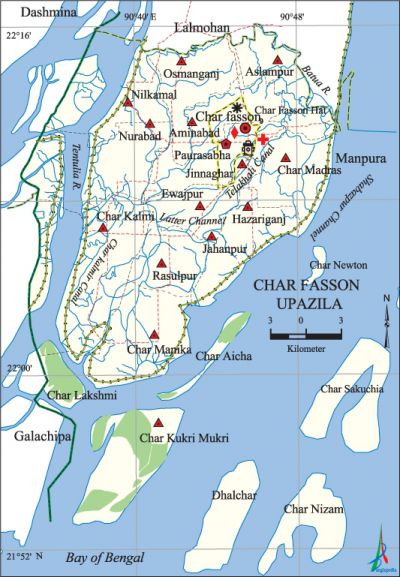Char Fasson Upazila
Char Fasson Upazila (bhola district) area 1106.31 sq km, located in between 21°54' and 22°16' north latitudes and in between 90°34' and 90°50' east longitudes. It is bounded by lalmohan upazila on the north, bay of bengal on the south, manpura upazila, Shahbazpur Channel and Bay of Bengal on the east, dashmina and galachipa upazilas on the west. There are more than 100 chars in the upazila, most noted of which are Char Kukri Mukri, Dhalchar, Char Manika, Char Aicha, Char Nizam, Char Newton.
Population Total 456437; male 228693, female 227744 (Census 2011); Muslim 403043, Hindu 10505, Buddhist 10, Christian 15 and others 20 (Census 2001).
Water bodies Main rivers: tentulia, Batua; Sagar Mohana and Betua Canal are notable.
Administration Char Fasson Thana, now an upazila, was formed in 1970.
| Upazila | ||||||||
| Municipality | Union | Mouza | Village | Population | Density (per sq km) | Literacy rate (%) | ||
| Urban | Rural | Urban | Rural | |||||
| 1 | 19 | 68 | 77 | 42915 | 413522 | 413 | 56.1 (2001) | 41.7 |
| Municipality | ||||||||
|
Area |
Ward |
Mahalla |
Population |
Density |
Literacy rate | |||
| 5.95 (2001) | 9 | 9 | 19595 | 2648 (2001) | 75.4 | |||
| Upazila Town | ||||||||
|
Area |
Mouza |
Population |
Density |
Literacy rate | ||||
| 25.71 (2001) | 3 | 23320 | 928 (2001) | 45.6 | ||||
| Union | ||||
| Name of union and GO code | Area (acre) | Population | Literacy rate (%) | |
| Male | Female | |||
| Abdullapur 13 | 7865 | 9053 | 9509 | 43.9 |
| Abu Bakarpur 11 | 10108 | 6032 | 6270 | 56.7 |
| Aminabad 15 | 6145 | 8529 | 8932 | 64.9 |
| Aslampur 19 | 8284 | 17731 | 17953 | 53.7 |
| Adhakha Nazrul Nagar 14 | 17635 | 10324 | 10533 | 29.9 |
| Osmanganj 95 | 7122 | 11442 | 11435 | 56.2 |
| Ewajpur 53 | 5736 | 10345 | 10585 | 50.6 |
| Char Kukri Mukri 70 | 20383 | 4274 | 4088 | 28.9 |
| Char Manika 47 | 10136 | 16125 | 15331 | 36.0 |
| Char Madras 38 | 11144 | 16676 | 16553 | 43.4 |
| Char Kalmi 28 | 8443 | 9588 | 9831 | 36.9 |
| Jahanpur 63 | 4533 | 10123 | 10361 | 35.0 |
| Jinnaghar 66 | 7232 | 11685 | 11635 | 45.6 |
| Dhal Char 51 | 5182 | 3915 | 3521 | 44.8 |
| Nilkamal 76 | 6965 | 15898 | 16444 | 32.1 |
| Nurabad 85 | 8830 | 20041 | 19692 | 31.5 |
| Mujib Nagar 73 | 6437 | 5454 | 4950 | 22.1 |
| Rasulpur 88 | 12715 | 15923 | 15665 | 41.1 |
| Hazariganj 57 | 7327 | 15413 | 14983 | 42.1 |
Source Bangladesh Population Census 2001 and 2011,Bangladesh Bureau of Statistics.

War of Liberation During the War of Liberation in 1971 an encounter was held between the freedom fighters and the Pak army at a place in between Aminabad and Osmanganj in which 11 freedom fighters were killed or wounded.
For details: see চরফ্যাশন উপজেলা, বাংলাদেশ মুক্তিযুদ্ধ জ্ঞানকোষ (Encyclopedia of Bangladesh War of Liberation), বাংলাদেশ এশিয়াটিক সোসাইটি, ঢাকা ২০২০, খণ্ড ৩।
Religious institutions Mosque 601, temple 5.
Literacy rate and educational institutions Average literacy 43.5%; male 43.1%, female 43.8%. Noted educational institutions: Char Fasson Higher Secondary School (1968), Fatema Matin Mahila College (1993), Char Fasson Tafnal Barret (T.B) Secondary School (1932), Char Fasson Girls' Secondary School (1968), Char Fasson Chairman Haidar (Model) Primary School (1932), Char Fasson Kara Matiya Kamil Madrasa (1945).'
Newspapers and periodicals Weekly: Fasson Barta (Defunct), Upakul Barta, Pratham Akash.
Cultural organisations Library 1, club 15, cinema hall 6, theatre group 4, stadium 1.
Main sources of income Agriculture 68.09%, non-agricultural labourer 4.81%, industry 0.23%, commerce 10.44%, transport and communication 1.96%, service 4.45%, construction 1.08%, religious service 0.34%, rent and remittance 0.29% and others 8.31%.
Ownership of agricultural land Landowner 50.69%, landless 49.31%; agricultural landowner: urban 53.98% and rural 50.35%.
Main crops Paddy, wheat, chilli, pulse, ground-nut, betel nut.
Extinct or nearly extinct crops Jute, sesame, linseed.
Main fruits Mango, jackfruit, papaya, banana, betel nut, watermelon.
Fisheries, dairies and poultries This upazila has a number of fisheries, dairies, poultries and hatcheries.
Communication facilities Roads: pucca 306 km, semi-pucca 16 km, mud road 430 km; waterway 46 km.
Extinct or nearly extinct traditional transport Palanquin, bullock cart.
Cottage industries Weaving, goldsmith, potteries, blacksmith, wood work, cane work.
Hats, bazars and fairs Hats, bazars and fairs are 58, most noted of which are Char Fasson Hat, Dular Hat, Goldar Hat, Letraganj Bazar, Chairman Hat, Shashi Bhusan Hat, Babur Hat and Baishakhi Mela.
Main exports Paddy, chilli, pulse, ground-nut, betel nut, hilsa fish and shrimp.
Access to electricity All the wards and unions of the upazila are under rural electrification net-work. However 18.7% of the dwelling households have access to electricity.
Sources of drinking water Tube-well 93.3%, tap 0.3% and others 6.4%.
Sanitation 49.5% of dwelling households of the upazila use sanitary latrines and 41.9% of dwelling households use non-sanitary latrines; 8.6% of households do not have latrine facilities.
Health centres Hospital 2, upazila health complex 1, family welfare centre 1, rural health centre 10, veterinary hospital 1.
Natural disasters Thousands of people of the upazila were killed in a devastating tidal bore in 1970.
NGO activities Operationally important NGOs are Coast Trust, brac, asa, and Action Aid. [Md Harun Rashid Helali]
References Bangladesh Population Census 2001 and 2011, Bangladesh Bureau of Statistics; Cultural survey report of Char Fasson Upazila 2007.
